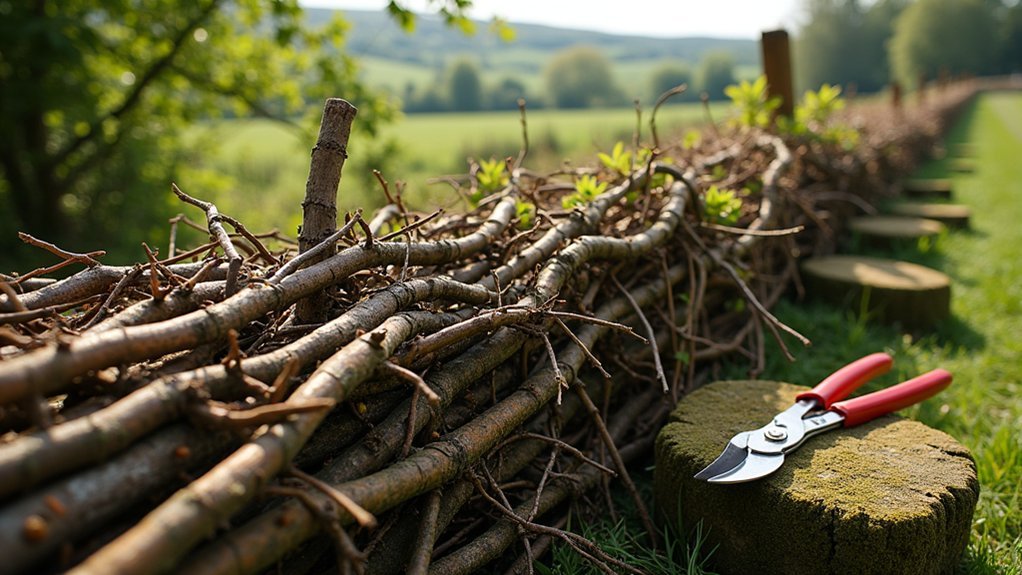For Yorkshire hedge laying success, master the thin cut technique by making upward-angled cuts near the ground with a billhook. Always lay stems facing uphill to optimize sap flow and encourage vigorous regrowth. Space your hazel or ash stakes about 50cm apart, driving them one-third into the soil for proper support. These traditional methods create the distinctive woven pattern that’s both functional and beautiful. The secrets of this centuries-old craft yield hedges that stand for generations.
Mastering the Thin Cut Technique Unique to Yorkshire Style

Three key elements define the Yorkshire thin cut technique that sets it apart from other regional styles.
First, you’ll need to make precise cuts close to the ground using a billhook, angling your cut upward to facilitate bending while ensuring vigorous regrowth. This foundation is essential for any successful laid hedge.
Precise ground-level cuts with upward angles create the critical foundation for hedge vitality and flexibility.
Second, position your stems with an upward slant when laying them along the hedge line. This orientation promotes ideal sap flow and encourages new shoots to emerge from the base, strengthening your hedge’s structure over time.
Finally, install sturdy stakes approximately 50cm apart to support your laid stems.
After hedge planting and laying, implement a regular trimming schedule to maintain the hedge’s density and appearance, allowing continuous regeneration through the thin cut technique.
Proper Uphill Laying Methods for Enhanced Sap Flow
Building on the thin cut technique, the uphill laying method represents a cornerstone of Yorkshire hedge laying craftsmanship. When you lay your stems, position them facing uphill to encourage ideal sap flow through the plant. This traditional approach guarantees vigorous regrowth and strengthens the hedge’s overall structure.
Before beginning, observe the natural growth direction of your stems. Cut them near the ground at an angle that facilitates upward sap movement. This positioning works with the plant’s biology rather than against it.
Support your laid stems with properly spaced stakes driven approximately 50cm apart. These stakes should secure the hedge while maintaining the essential uphill slant.
Selecting and Spacing Stakes for Yorkshire’s Distinctive Hedge Structure

Selecting the right stakes forms a critical foundation for any successful Yorkshire hedge. When you’re gathering materials, choose straight, sturdy hazel or ash stakes measuring 2-3 meters tall. As experienced hedge layers know, these species offer the perfect balance of strength and flexibility needed for weaving with laid stems.
When spacing stakes, maintain approximately 50cm between each one to create proper support for your hedge structure. Drive them into the ground about one-third of their length to guarantee they’ll withstand wind pressure.
- Stakes and bindings work together to create the distinctive woven pattern Yorkshire hedges are known for
- Proper spacing prevents weak points where wildlife might penetrate
- Alternating stakes with woven branches dramatically increases structural integrity
- Your hedge’s longevity depends largely on initial stake placement and quality
Frequently Asked Questions
What Are the Disadvantages of Hedge Laying?
You’ll face disadvantages like labor-intensive work, potential structure weakness, limited skilled practitioners, restricted seasonal timeframe, and specific tool requirements. It’s physically demanding and requires proper technique to avoid premature hedge failure.
How Long Does Hedge Laying Last?
Your hedge laying can last 20-30 years if you maintain it properly. With regular trimming and management, you’ll prevent woodland reversion. Some historical hedges have even survived for 800+ years with proper care.
How High Should a Hedge Be for Laying?
Your hedge should be 1.2 to 1.5 meters (4-5 feet) tall before laying. You’ll cut stems about 10-15cm above ground and aim for a final height of 1 meter when complete.
How to Lay a Hedge for Beginners Step by Step?
Start by clearing lower branches, cut stems at an angle, lay them diagonally upward, insert stakes every 50cm, and bind with hazel rods. You’ll create a living, growing fence that’s both beautiful and functional.
What Time of Year for Hedge Laying?
You’ll want to lay hedges between October and March when trees are dormant. This winter timing avoids bird nesting season, makes working easier without foliage, and follows traditional practices for healthier regrowth.
In Summary
You’ll find Yorkshire hedge laying rewarding once you’ve mastered these regional techniques. Remember to make those distinctive thin cuts, always lay stems uphill to maintain proper sap flow, and carefully position your stakes for the authentic Yorkshire structure. With practice, you’ll develop the rhythm and precision that makes this traditional craft both functional and beautiful. Your hedges will thrive for generations while preserving this valuable countryside skill.





Leave a Reply